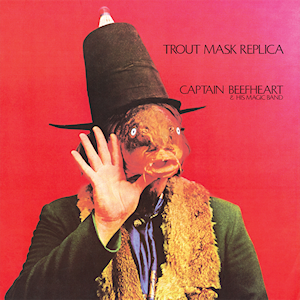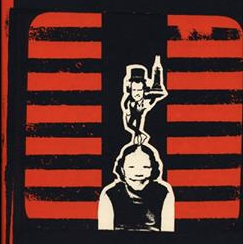Unfortunately, I don’t have a copy of one of the greatest experimental rock albums of all time, which would happen to be Trout Mask Replica. It was released on CD many times, but it never made its way to iTunes for some strange reason (I get lots of my music off of iTunes), but I was lucky enough to hear the full thing on YouTube plenty of times before I would have a chance of buying it. I remember when I first listened to it a couple years ago, and I thought it was one of the most awesome things I had ever listened to. In fact, some of this was recorded in an old abandoned house! Don Van Vliet, as is the real name of Captain Beefheart, sure is a musical genius!
I remember reading the album’s credits, but they looked rather plain (but it did give out some of the instruments used). So, for this reason. when I describe each of the tracks for this review, I’m going to give personnel credits to each of the songs, just to add to the album’s weirdness!
“Frownland”-An electric boogie starts, but Don’s vocals quickly deconstructs the song into interlocking guitar noise. Not like noisecore in the Gerogerigegege fashion, but more in an electric blues style. This is a good way to start the album, by the way!
Captain Beefheart-lead vocals
Antennae Jimmy Semens-lead guitar, steel appendage guitar (slide guitar with a steel slide)
Zoot Horn Rollo-lead guitar, glass finger guitar (slide guitar with a glass slide)
Rockette Morton-bass guitar
Drumbo-drums
“The Dust Blows Forward n’ the Dust Blows Back”-A lo-fi a capella sung by Don, and he pauses the cassette recorder several times throughout the song, meaning that the song could’ve been improvised
Captain Beefheart-vocals
“Dachau Blues”-A song about the Holocaust. This song starts in an ominous manner, and Don’s voice sounds more deeper. The drums began to have a much slower beat. He also plays a deep droning bass clarinet in the background, at times sounding like some of the music you hear in the original Thomas the Tank Engine series. At the end, there’s a field recording of Rockette Morton giving an impromptu narrarion.
Captain Beefheart-lead vocals, bass clarinet
Antennae Jimmy Semens-steel appendage guitar
Zoot Horn Rollo-glass finger guitar
Rockette Morton-bass guitar, narration
Drumbo-drums
Frank Zappa-field recording
“Ella Guru”-An interlocking song about a pretty woman. Throughout the song, you hear random voices talking, and Antennae performs vocals with his hand cupped over his mouth. This was credited in the notes as a “flesh horn”.
Captain Beefheart-lead vocals, voice
Antennae Jimmy Semens-steel appendage guitar, flesh horn
Zoot Horn Rollo-glass finger guitar
Rockette Morton-bass guitar
The Mascara Snake-voice
Drumbo-drums
Frank Zappa-voice
“Hair Pie: Bake 1”-This track is a “bush recording”, beginning with an improv duo between Don’s saxophone and The Mascara Snake’s bass clarinet. Since this is a field recording, you can hear various outside sound effects. Both instruments were panned perfectly, in an atmospheric manner. Afterwards, the Magic Band strikes up a tune, recorded inside of the house that they recorded this in, with the other two instruments outside. Later, the Magic Band’s music gradually becomes louder, eventually drowning out Captain Beefheart and the Mascara Snake. The track ends with Don talking to two unidentified neighbors, with sounds such as doors opening and closing, an airplane flying, a dog barking, and some other outside sounds.
Captain Beefheart-tenor saxophone, voice
The Mascara Snake-bass clarinet
Antennae Jimmy Semens-steel appendage guitar
Zoot Horn Rollo-glass finger guitar
Rockette Morton-bass guitar
Drumbo-drums
Frank Zappa-bush recording, effects
Dialogue provided by two anonymous contributors
“Moonlight On Vermont”-A more garage rock-oriented tune centered around distorted guitars. In the middle of the track, you hear some guitar feedback, and some more feedback while the band are still playing.
Captain Beefheart-lead vocals
Antennae Jimmy Semens-steel appendage guitar, feedback
Zoot Horn Rollo-glass finger guitar
Gary “Magic” Marker-bass guitar
Drumbo-drums
“Pachuco Cadaver”-This begins with Don talking about “a squid eating dough in a polyethylene bag”. After that comes a jam driven by Rockette Morton’s bass. A strange tenor saxophone solo comes in later on.
Captain Beefheart-lead vocals, tenor saxophone, voice
Antennae Jimmy Semens-steel appendage guitar
Zoot Horn Rollo-glass finger guitar
Rockette Morton-bass guitar
Drumbo-drums
“Bill’s Corpse”-I can’t describe this song!
Captain Beefheart-lead vocals
Antennae Jimmy Semens-steel appendage guitar
Zoot Horn Rollo-glass finger guitar
Rockette Morton-bass guitar
Drumbo-drums
“Sweet Sweet Bulbs”-This song has a more country feel to it. The lyrics describe a garden.
Captain Beefheart-lead vocals
Antennae Jimmy Semens-steel appendage guitar
Zoot Horn Rollo-glass finger guitar
Rockette Morton-bass guitar
Drumbo-drums
“Neon Meate Dream of a Octafish”-This is a jazzy tune driven by Don’s vocals, which sounds like it was processed through a small speaker to give it a very tinny quality. He also plays a simran horn and an oboe musette.
Captain Beefheart-robot voice, simran horn, oboe musette
Antennae Jimmy Semens-steel appendage guitar
Zoot Horn Rollo-glass finger guitar
Rockette Morton-bass guitar
Drumbo-drums
“China Pig”-This is a lo-fi delta blues piece played by Doug Moon on acoustic guitar with Don singing about a piggy bank. Near the end of the song, there is a tape splicing sound effect.
Captain Beefheart-lead vocals, voice
Doug Moon-acoustic guitar
Gary “Magic” Marker-tape splice
“My Human Gets Me Blues”-This is another interlocking song that has really weird vocals.
Captain Beefheart-lead vocals
Antennae Jimmy Semens-steel appendage guitar
Zoot Horn Rollo-glass finger guitar
Rockette Morton-bass guitar
Drumbo-drums
“Dali’s Car”-A minimalist/modern classical-style guitar duel without any other accompaniment.
Antennae Jimmy Semens-steel appendage guitar
Zoot Horn Rollo-glass finger guitar
“Hair Pie: Bake 2”-The same rock melody from “Hair Pie: Bake 1”, but this time was recorded in an actual studio. The track ends with the sound of sleigh bells that gets sped-up to sound like a vacuum cleaner. Don was indeed a vacuum cleaner salesman at one point.
Captain Beefheart-sleigh bell tin tear drop
Antennae Jimmy Semens-steel appendage guitar
Zoot Horn Rollo-glass finger guitar
Rockette Morton-bass guitar
Drumbo-drums
Frank Zappa-special effect
“Pena”-Beginning with some studio dialogue, this leads into a really weird tune with high-pitched, very nonsensical, girly ranting backed by high-pitched barking.
Antennae Jimmy Semens-lead vocals, steel appendage guitar
Captain Beefheart-voice, barking
Zoot Horn Rollo-glass finger guitar
Rockette Morton-bass guitar
The Mascara Snake-voice
Drumbo-drums
Frank Zappa-voice
“Well”-The album’s second a capella. This, however, is not a lo-fi recording. The reverberation in Don’s voice comes from the house’s acoustic setting.
Captain Beefheart-lead vocals
“When Big Joan Sets Up”-The album’s lognest track, coming in at over 5 minutes. In this song, Don plays an even weirder tenor saxophone solo. Some of the instruments stop and start at a couple of points.
Captain Beefheart-lead vocals, tenor saxophone
Antennae Jimmy Semens-steel appendage guitar
Zoot Horn Rollo-glass finger guitar
Rockette Morton-bass guitar
Drumbo-drums
“Fallin’ Ditch”-This bluesy track begins with a musique concrete intro of sound effects and dialogue. The sound effects heard in the intro are:
- An amplified recording of someone munching on food with Laurie Stone, Captain Beefheart’s girlfriend at the time, talking in the background
- A recording of Laurie’s laughter that was sped-up, with some clacking sounds accompanying it
- Tiny static
- A tape-spliced voice that darts like a laser beam
Captain Beefheart-lead vocals, voice
Antennae Jimmy Semens-steel appendage guitar
Zoot Horn Rollo-glass finger guitar
Rockette Morton-bass guitar, narration
Drumbo-drums
Laurie Stone-voice
Frank Zappa-tape effects
“Sugar n’ Spikes”-I can’t describe this track, either!
Captain Beefheart-lead vocals
Antennae Jimmy Semens-steel appendage guitar, background vocals
Zoot Horn Rollo-glass finger guitar
Rockette Morton-bass guitar
Drumbo-drums
“Ant Man Bee”-This track has Don playing a soprano saxophone and a tenor saxophone simultaneously.
Captain Beefheart-lead vocals, tenor and soprano saxes played simultaneously
Antennae Jimmy Semens-steel appendage guitar
Zoot Horn Rollo-glass finger guitar
Rockette Morton-bass guitar
Drumbo-drums
“Orange Claw Hammer”-The album’s last a capella, sung in the form of a sea shanty. At one point, when Don pauses the tape recorder between verses, his voice warps a little. This is common in most lo-fi recorders of the time.
Captain Beefheart-vocals
“Wild Life”-Much of the guitars in the beginning of this track have a proto-grunge feel to it due to the distortion. Later, a jazzy bass clarinet solo comes in.
Captain Beefheart-lead vocals, bass clarinet
Antennae Jimmy Semens-steel appendage guitar
Zoot Horn Rollo-glass finger guitar
Rockette Morton-bass guitar
Drumbo-drums
“She’s Too Much for My Mirror”-This song begins with a radio announcer-style voice. After that is a short jam about a beautiful woman. At the end, Don’s voice echoes off into the distance, with a tiny bit of commentary to end it all.
Captain Beefheart-lead vocals, voice
Antennae Jimmy Semens-steel appendage guitar
Zoot Horn Rollo-glass finger guitar
Rockette Morton-bass guitar
Drumbo-drums
Dick Kunc-announcement
“Hobo Chang Ba”-This track is driven by jingle bells. At one point, you hear a tiny flute noise
Captain Beefheart-lead vocals, jingle bells
Antennae Jimmy Semens-steel appendage guitar
Zoot Horn Rollo-glass finger guitar, flute noise
Rockette Morton-bass guitar
Drumbo-drums
“The Blimp (mousetrapreplica)”-In this song, Frank Zappa’s group, the Mothers of Invention, plays their composition “Charles Ives”, while Antennae Jimmy Semens recites impromptu poetry by way of telephone, with Don accompanying him on a hunting horn. In some points, the drums roll off into space, some brass instruments honk like car horns, and a piano can be heard futzing about.
Captain Beefheart-hunting horn, voice
Antennae Jimmy Semens-voice
Roy Estrada-bass guitar
Arthur Tripp III-drums, percussion
Don Preston-piano
Ian Underwood-tenor saxophone
Bunk Gardner-alto saxophone
Buzz Gardner-trumpet
Frank Zappa-voice, telephone
“Steal Softly Thru Snow”-I can’t describe this track as well!
Captain Beefheart-lead vocals
Antennae Jimmy Semens-steel appendage guitar
Zoot Horn Rollo-glass finger guitar
Rockette Morton-bass guitar
Drumbo-drums
“Old Fart At Play”-One of the album’s best-known songs. This consists of the band accompanying the Captain’s bizarre poetic ranting. This is also where the title of the album comes in. At the end, Antennae can be heard speaking in a hippie manner.
Captain Beefheart-voice
Antennae Jimmy Semens-steel appendage guitar, voice
Zoot Horn Rollo-glass finger guitar
Rockette Morton-bass guitar
Drumbo-drums
“Veteran’s Day Poppy”-The track ends with a song about some veteran’s day poppy, but if the lyrics are any indication, the song might have been about a psychedelic drug.
Captain Beefheart-lead vocals
Antennae Jimmy Semens-steel appendage guitar
Zoot Horn Rollo-glass finger guitar
Gary “Magic” Marker-bass guitar
Drumbo-drums



